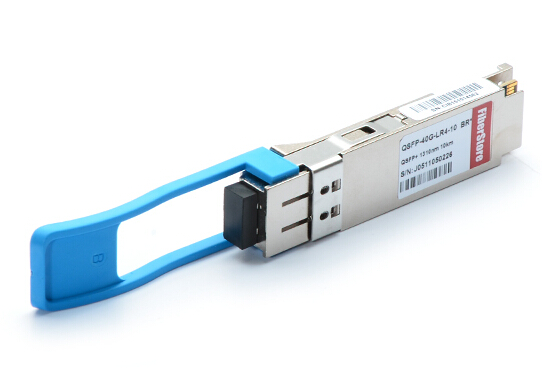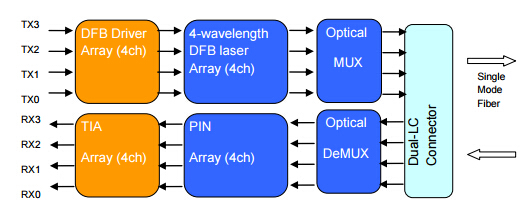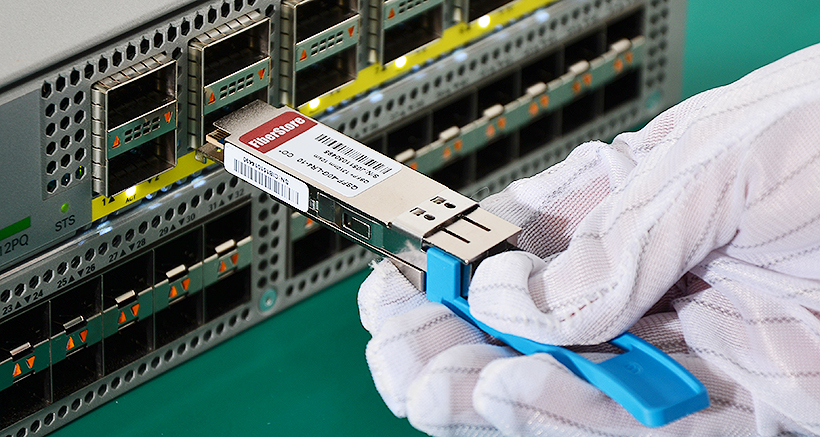Applications and equipment in the network infrastructures and data centers are evolving dramatically, and these advancements would generate more bandwidth than ever. Apparently, multiple 10GbE links offer a common solution to achieve higher intra-rack bandwidth, however, as individual streams routinely reach 10Gbps speeds, it is necessary to have native 40GbE links to provide better performance. Thus, a cabling upgrade is required to ensure smooth migration to 40G network, while the 40G QSFP+ LR4 module is considered as an ideal and effective alternative.
General Description of 40G QSFP+ LR4 Module
Before introducing the 40G QSFP+ LR4 module, let’s just take a glimpse of the 40G QSFP+ module firstly. A QSFP+ (quad small form-factor pluggable plus) module is the updated version of QSFP providing four 10-gigabit transmit and receive channels in a single pluggable optical module, for an aggregate bandwidth of 40 Gbps. QSFP+ module nowadays is widely adopted to provide high-density and low-power 40 Gigabit Ethernet connectivity options.
40G QSFP+ LR4 module is one of the common 40 Gigabit Ethernet connectivity options. It supports link lengths of up to 10 kilometers over a standard pair of single-mode fiber with duplex LC connectors. The letter "L" stands for long, the "R" indicates the type of interface with 64B/66B encoding and the numeral 4 means that the transmission is carried out over a ribbon fiber with four single-mode fibers in every direction, each of them has a 10 Gbps data rate.

How Dose 40G QSFP+ LR4 Function?
The 40G QSFP+ LR4 module converts 4 inputs channels of 10Gbps electrical data to 4 CWDM optical signals, and multiplexes them into a single channel for 40Gbps optical transmission.
To get a better understanding of the working process of 40G QSFP+ LR4 module, we can put it this way: the optical signal is combined by the MUX parts as a 40Gbps data, propagating out of the transmitter module from the SMF. The receiver module accepts the 40Gbps CWDM optical signals input, and de-multiplexes it into 4 individual 10Gbps channels with different wavelength. Each wavelength light is collected by a discrete photo diode, and then outputted as electric data after amplified by a TIA.

Installation Guide to 40G QSFP+ LR4
Like we have stated previously, 40G QSFP+ LR4 serves as an indispensable component for migrating to 40G network. It also brings much convenience and flexibility since one can install a QSFP+ LR4 module without powering off the system. But how to install it to your existing system? Here are some step-by-step procedures that may help.

1. Remove the QSFP+ LR4 module from its antistatic container and remove the dust covers from the module optical connector. If your module has a protective pad covering the card-edge connector, remove it. Store the antistatic container, dust covers, and card-edge connector protective pad in a clean location from which they can be easily retrieved if you need to uninstall the module.
2. Remove any rubber dust covers from the port where you are installing the QSFP+ LR4 module.
3. Holding the QSFP+ LR4 module by its sides, insert the QSFP+ module into the port on the switch or module.
4. Slide the QSFP+ LR4 module into the port until you hear it click into place.
5. Push up on the handle to secure the QSFP+ LR4 module in the switch.
Notice: QSFP+ modules contain Class 1M lasers. Invisible laser radiation can occur when laser connections are unplugged. Do not stare into the beam.
Conclusion
As 40G network has become an irreversible trend to accommodate greater bandwidths and ensure better performance, it allows of no delay to employ the efficient QSFP+ LR4 module to your data center infrastructures. FS.COM offers various of 40G QSFP+ LR4 modules compatible with the major brands on the market, such as Cisco, Juniper and Dell. All of them are fully tested to provide an end-to-end solution that is easier to maintain, helping improve the availability of data center networks. For more information, please visit www.fs.com.

No comments:
Post a Comment